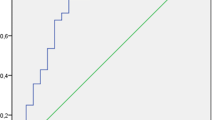Abstract
It is well known that the serum procalcitonin (PCT) levels increase in severe bacterial infections. However, there is little information about the levels of PCT in diverse diseases except mainly the infectious diseases. The aim of this study was to investigate the progress of serum levels of PCT together with traditional acute phase reactants in children with familial Mediterranean fever (FMF) during the attack and attack-free periods and to test whether PCT could help to diagnose the attack in FMF patients. The study group comprised 21 FMF patients (mean age 10 ± 4.6 years) and 19 healthy controls (mean age 10.6 ± 4.2 years). Serum levels of PCT and traditional acute phase reactants were measured during the attack and attack-free periods. Blood samples were obtained within the first 6–24 h of the attack period, 7 days later, and at least 2 months after the attack. Traditional acute phase reactants (hs-CRP, ESR, and fibrinogen) during the attack period were significantly higher than the attack-free levels and controls. PCT levels of the FMF patients during the attack period were also significantly higher than the attack-free and control group levels (median values, 0.044 ng/ml vs. 0.028 ng/ml and 0.031 ng/ml, P = 0.04, respectively). Although this difference was statistically significant (P = 0.04), median PCT values of the attack, attack-free period, and healthy subjects were lower than 0.05 ng/ml. As a result, these findings suggested that PCT levels were not conspicuously affected from inflammation and could not be used as a descriptive marker for attack in FMF patients.
Similar content being viewed by others
References
Livneh A, Langevitz P (2000) Diagnostic and treatment concerns in familial Mediterranean fever. Baillieres Best Pract Res Clin Rheumatol 14:477–498
Ben-Chetrit E, Levy M (1998) Familial Mediterranean fever. Lancet 351:659–664
Korkmaz C, Ozdogan H, Kasapçopur O, Yazici H (2002) Acute phase response in familial Mediterranean fever. Ann Rheum Dis 61:79–81
Schaner PE, Gumucio DL (2005) Familial Mediterranean fever in the post-genomic era: how an ancient disease is providing new insights into inflammatory pathways. Curr Drug Targets Inflamm Allergy 4:67–76
Yalçinkaya F, Cakar N, Acar B, Tutar E, Güriz H, Elhan AH, Oztürk S, Kansu A, Ince E, Atalay S, Girgin N, Doğru U, Aysev D, Ekim M (2007) The value of the levels of acute phase reactants for the prediction of familial Mediterranean fever associated amyloidosis: a case control study. Rheumatol Int 27:517–522
Nijsten MW, Olinga P, The TH, de Vries EG, Koops HS, Groothuis GM, Limburg PC, ten Duis HJ, Moshage H, Hoekstra HJ, Bijzet J, Zwaveling JH (2000) Procalcitonin behaves as a fast responding acute phase protein in vivo and in vitro. Crit Care Med 28:458–461
Oberhoffer M, Stonans I, Russwurm S, Stonane E, Vogelsang H, Junker U, Jäger L, Reinhart K (1999) Procalcitonin expression in human peripheral blood mononuclear cells and its modulation by lipopolysaccharides and sepsis-related cytokines in vitro. J Lab Clin Med 134:49–55
Schneider HG, Lam QT (2007) Procalcitonin for the clinical laboratory: a review. Pathology 39:383–390
Breda L, Nozzi M, De Sanctis S, Chiarelli F (2010) Laboratory tests in the diagnosis and follow-up of pediatric rheumatic diseases: an update. Semin Arthritis Rheum 40:53–72
Eberhard OK, Haubitz M, Brunkhorst FM, Kliem V, Koch KM, Brunkhorst R (1997) Usefulness of procalcitonin for differentiation between activity of systemic autoimmune disease (systemic lupus erythematosus/systemic antineutrophil cytoplasmic antibody-associated vasculitis) and invasive bacterial infection. Arthritis Rheum 40:1250–1256
Gendrel D, Raymond J, Coste J, Moulin F, Lorrot M, Guérin S, Ravilly S, Lefèvre H, Royer C, Lacombe C, Palmer P, Bohuon C (1999) Comparison of procalcitonin with C-reactive protein, interleukin 6 and interferon-alpha for differentiation of bacterial versus viral infections. Pediatr Infect Dis J 18:875–881
Schwenger V, Sis J, Breitbart A, Andrassy K (1998) CRP levels in autoimmune disease can be specified by measurement of procalcitonin. Infection 26:274–276
Meisner M (2000) Procalcitonin. Georg Theime Verlag, Stuttgart
http://www.procalcitonin.com/. Accessed 18 June 2011
Delèvaux I, André M, Colombier M, Albuisson E, Meylheuc F, Bègue RJ, Piette JC, Aumaître O (2003) Can procalcitonin measurement help in differentiating between bacterial infection and other kinds of inflammatory processes? Ann Rheum Dis 62:337–340
Wanner GA, Keel M, Steckholzer U, Beier W, Stocker R, Ertel W (2000) Relationship between procalcitonin plasma levels and severity of injury, sepsis, organ failure, and mortality in injured patients. Crit Care Med 28:950–957
Christ-Crain M, Jaccard-Stolz D, Bingisser R, Gencay MM, Huber PR, Tamm M, Müller B (2004) Effect of procalcitonin-guided treatment on antibiotic use and outcome in lower respiratory tract infections: cluster-randomised, single-blinded intervention trial. Lancet 363:600–607
Quintana G, Medina YF, Rojas C, Fernandez A, Restrepo JF, Rondon F, Iglesias A (2008) The use of procalcitonin determinations in evaluation of systemic lupus erythematosus. J Clin Rheumatol 14:138–142
Colak B, Gurlek B, Yegin ZA, Deger SM, Elbek S, Pasaoglu H, Dogan I, Ozturk MA, Unal S, Guz G (2008) The relationship between the MEFV genotype, clinical features, and cytokine-inflammatory activities in patients with familial mediterranean fever. Ren Fail 30:187–191
Kisacik B, Kalyoncu U, Erol MF, Karadag O, Yildiz M, Akdogan A, Kaptanoglu B, Hayran M, Ureten K, Ertenli I, Kiraz S, Calguneri M (2007) Accurate diagnosis of acute abdomen in FMF and acute appendicitis patients: how can we use procalcitonin? Clin Rheumatol 26:2059–2062
Conflict of interest
The authors declare that they have no conflict of interest.
Author information
Authors and Affiliations
Corresponding author
Rights and permissions
About this article
Cite this article
Yüksel, S., Ekim, M., Özçakar, Z.B. et al. The value of procalcitonin measurements in children with familial Mediterranean fever. Rheumatol Int 32, 3443–3447 (2012). https://doi.org/10.1007/s00296-011-2206-2
Received:
Accepted:
Published:
Issue Date:
DOI: https://doi.org/10.1007/s00296-011-2206-2




